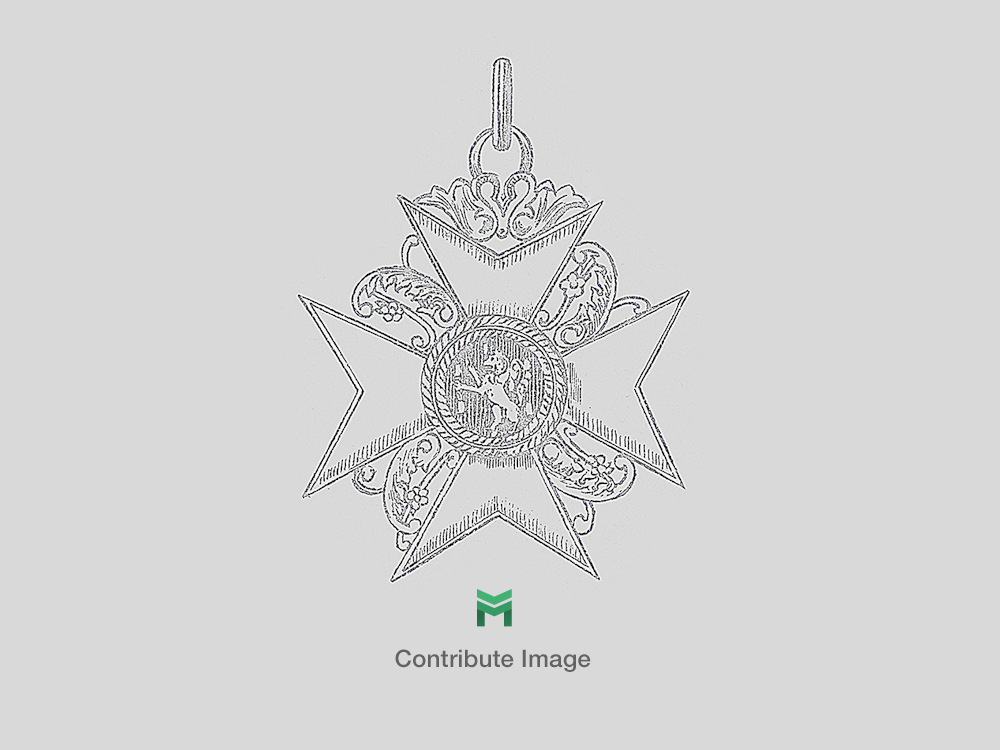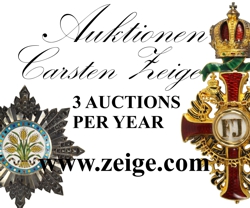Military Order of St. Henry, Type I, Commander
SKU: 01.SXK.0102.101.01
Estimated market value:

Estimated market value:
Attributes
Physical Description
A George’s cross, constructed of gold and enamel. In between the cross arms are white enamelled eagles with golden edges and golden crowns. The cross arms each feature a round indentation on the side. The obverse cross arms are enamelled in dark red with broad white enamelled edges. Each arm features the crowned monogram ‘AR III’. The centre medallion is golden and features the left-facing portrait of Emperor Henry II in coloured enamels. The golden medallion ring features the circular inscription ‘S. HENRICUS IMPERATOR’ in black. The reverse is similar, except that the cross arms are one third black enamelled on the outer part and two thirds white enamelled on the inner part, and each arm features two crossed red enamelled swords. The centre medallion features the inscription ‘PIETATE ET BELLICA VIRTUTE’ (‘for piety and bellicose bravery’). On a loop for suspension, on a purple ribbon with silver side stripes.
History
The Military Order of St. Henry was first instituted by Prince-Elector Friedrich August II of Saxony, who was also King of Poland as Augustus III, on his 40th birthday. The original title of the order was the "Knightly Military Order of St. Henry".
The order was awarded to the crown prince and several generals in recognition of military and wartime merit. This order is the oldest German war medal, and until 1918, was the highest Saxon honour for bravery.
Type I decorations were awarded from 1736 to 1768. According to the statutes of 1736, the order was comprised of six Commanders and 30 Knights. The decoration is slightly larger for the Commander than the Knights, but is of the same design. The obverse arms present the crowned monogram "AR III" for Augustus Rex III. A total of 31 Type I decorations were awarded, including 22 in 1769, four in 1737, three in 1738, and two in 1745.
Friedrich August II died in 1763, and his successor, Prince-Elector Friedrich Christian died not three months later that same year. Prince-Elector Friedrich August III, at this time only 13 years of age, was too young to rule, and his uncle, Prince Xaver ruled in his stead.
Xaver renewed the order on August 25, 1768, less than a month before Friedrich August III began his reign. The order was expanded to include three main grades, Grand Cross with Grand Cross Breast Star, Commander Cross, and Small Cross, as well as a decoration for officials of the order. The order continued to be awarded in recognition of military merit. All members of the order were called "Knights".
In 1765, the end of the Saxon/Polish Union had occurred. Therefore, the Polish eagles were removed from the order and replaced by green enamelled diamond shaped wreaths between the arms. The medallion was changed from a profile to a standing emperor with the inscription XAVERIUS P P D E AD S INSTIT 1768, translating to "Xaver, Prince of Poland, Duke and Administrator of Saxony has (the order) erected in 1768". The reverse inscription was changed to VIRTUTI IN BELLO.
Friedrich August III was very dissatisfied with his uncle having claimed the order for himself by renewing it just before he abdicated. Therefore, he did not award the order for many years. He was forced to make an exception for the heroic deeds of some of his officers during the Coalition Wars of 1793 to 1796. The only class that was awarded during this time was the Small Cross, with minor changes compared to the form that had been instituted by Xaver.
Minor changes to the order also occurred in 1806, following the Poznan Peace. The crossed swords on the reverse were replaced with the new royal national coat of arms.
On March 17, 1976, Friedrich August III instituted a Gold and a Silver Merit Medal for non-commissioned officers and enlisted men.
In 1807, Prince-Elector Friedrich August III became King of Saxony as Friedrich August I. Because of this, the ducal crown on top of the crosses was changed to a regal crown.
Friedrich August I died in 1827. Type III awards were awarded during the period of 1829 to 1918. On December 23, 1829, the order was renewed by King Anton. He changed the name to "Royal Saxon Military Order of St. Henry" and added the grades of Grand Commander and Grand Commander Breast Star. He also attached the gold and silver military merit medals to the order as its V class.
Over the course of 182 years, this order was awarded a total of 3,843 times. The military medals in gold were awarded 403 times (including 47 copper and gold-plated), as well as 8,995 silver military merit medals, the majority of which were awarded during the First World War.
The original motto of the Order is PIETATE ET BELLICA VIRTUTE, meaning “For Piety and Bellicose Bravery”, until 1768, when it was altered to VIRTVTI IN BELLO meaning “For Bravery in War”. Makers of this order include Karl Wilhelm Hoeckner, Friedrich Ulbricht, and Rothe.

Versions
$50,000 USD
Gold/Enamelled
Obv: AR III S. HENRICUS IMPERATOR Rev: PIETATE ET BELLICA VIRTUTE
It is unlikely that any specimen is still in existence today.


Comments
Sign in to comment and reply.


Scroll Top